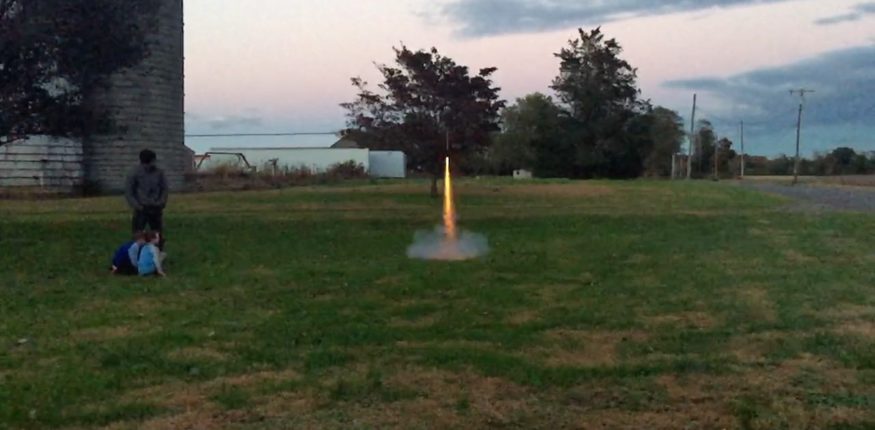During our October trip back to the family farm to visit the grandparents, my mom bought this rocket kit for the boys. It was a timely gift, as the boys have been enjoying youtube videos of SpaceX Falcon launches. Building and launching model rockets with the boys brought back fond childhood memories. Unpacking the kit brought forth considerable nostalgia. I was emotionally moved to find that the Estes rocket kits are largely unchanged from when I was a kid. The engines and igniters are identical, the balsa wood fins are identical. Seriously, they could have made the pieces thirty years ago and stockpiled them and shipped them to us, down to the paper piece on the igniter and the ink printing on the side of the kraft-paper glue-rolled engine.
When I was a kid, building and launching model rockets provided an academic stepping stone to studying electricity (making fire using batteries and a switch!) and chemistry (can I mix up my own propellant from kitchen stuff?!). In fact, when rummaging through my files from my childhood I found a whitepaper describing how to make a sugar-based rocket propellant. I had mailed off a check for $5 to some random guy that sent me back a four-page whitepaper (in the mail, yes) on how to make rocket propellant on the kitchen stove from commonly available materials. At this point some friend comment’s: “little surprise this guy went on to become an explosives scientist.”
But now, current day, raising my own kids, I am thankful for the wonderful resurgence of space-based action. SpaceX—and the rocket companies that are being dragged forward in its wake—are inspirational. Moreover, I don’t have to convince my kids of it. This isn’t a case of dad trying to convince his kids that space is exciting. They choose to watch the youtube videos; they choose to play ios rocket games on the phone. Jasper informed me this morning that the Saturn V is currently his favorite rocket, in the non-sequitur nimble-minded multi-tasking way that kids whip out to out-maneuver their dad’s failing old brain. (8AM, urgently getting ready to go skiing: “Jasper, do you want some eggs?” “No, dad, the Saturn V is my favorite rocket.”)
It’s wonderful how many youtube videos of modern rocket launches you can find with the classic “10…9…8…7…6…5…4…3…2…1…BLASTOFF” countdown. The countdown thing—as in, being able to countdown from ten—has been a capability milestone for each of our boys right around age 3, whether it’s connected to an awesome rocket launch video or not. But my point is that there are a LOT of exciting videos to watch of modern-day rocket launches. One of their favorite SpaceX videos to watch is the inaugural launch of the Falcon Heavy, and it is thirty-four minutes long. I would have wagered that it would bore the boys (check it out, you’ll see what I mean), but they all dig it because of the suspense and the cheering and the continual excitement of the dorky engineer commentary throughout. (Karen also wants me to point out that she cried during this video because she was so excited and the boys might have been inspired by the tears she shed.)
At the moment, my boys are mostly excited about rockets themselves. The fire, the blast, the propulsion, the speed, the exiting of our atmosphere. The crashing! (current favorite video: “Biggest Booms in Rocket History”). Sometimes, the successful landing.
Building and firing off the model rocket is a way to spiritually connect with the exciting developments in modern space technology… and obviously it is a fantastic learning experience for kids. Half of it is crafts—you’re using Elmer’s glue and maybe doing some sanding to smooth the fins and even painting if you want. Then you can include lessons on electricity, as the launch system is a simple electric hot-wire match. The final quarter is genuine rocketry, and can include discussions of mass and aerodynamics and ballistics etc. As simple or as complicated as you want to get. And all of that for under $50. Hard to beat.
Getting ready for space and visiting different planets and colonizing them is, without doubt, the biggest adventure ever. Even the idea of space exploration and other planets and colonizing and probes and martian landers is adventurous. Talking about travelling to unknown and unexplored places: the challenges, the solitude, the courage required, the preparation necessary, those things are the currency of the adventurous spirit.
If you want see if your own kids (or yourself), might get caught up in the excitement, here are some recommendations from my recent experiences with my boys:
1. Estes Model Rocket Kits from Amazon


There are a number of options for beginner kits, search for Estes Model Rockets on Amazon and let your kid help pick one out to involve them in the process. My mother bought them a $40 kit that has two rockets. The larger rocket in the kit is quick to put together, the smaller one a bit more arts-and-crafts but flies way higher. It has everything you need except the engines, which you can get here. To be clear: the kit above has the launch stand and the electric igniter system, and two separate rockets.
2. Youtube Videos
Lately, we are totally infatuated with the “Everyday Astronaut” youtube channel. This guy is a nerd, and he’s an awesome nerd, and he’s a nerd that my kids love, which is a rare combination. His videos are legit. He also occasionally employs some software called Kerbal Space Program in his videos to illustrate what works and doesn’t work, rocketry-wise. I’ve looked into it briefly and it’s way too complicated for my kid’s current level, but maybe in the future. Below are two videos from Everyday Astronaut that the boys keep re-watching:
3. Ios apps for building and launching rockets
I bought these both at the same time, spent ten minutes briefing the boys on how to work the app, and they now play by themselves. Every once in a while I’ll hear a “I got into orbit dad!” exclamation from the living room. I haven’t spent much time playing them myself, but they seem to be easy enough—but not too easy—for my 5 and 7 year-old, as a point of reference. If they have learned nothing else, they now intuitively understand why you can’t just add a huge stack of fuel to a single-stage rocket to get it into space—because their little creations will sit there on the launch pad with engines burning fuel blast, struggling to rise of the ground, and then fall back to earth and explode. Lesson learned. Full disclosure, they often build a rocket that is successful and nimble, just so that they have the opportunity to turn it upside down from a high altitude and run it into the ground at the maximum speed and laugh at the explosion.



